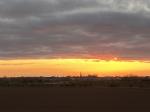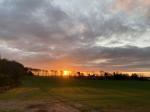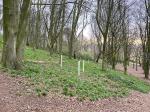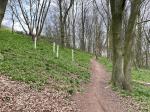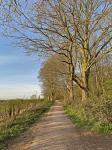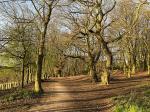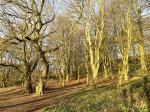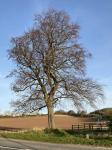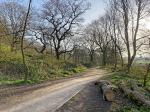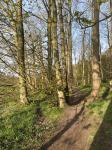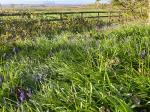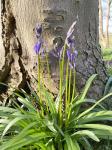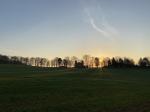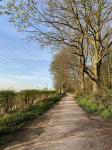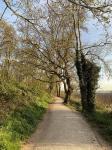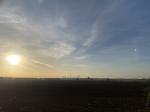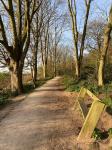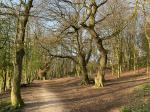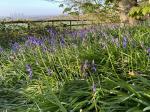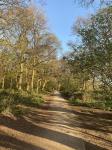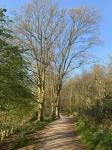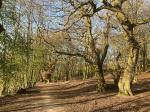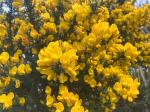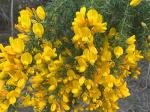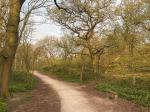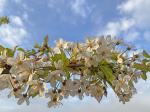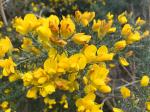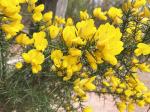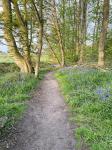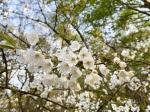Brayton Barff Through the Seasons.
Set in the Vale of York, South West of the market town of Selby and between the villages of Thorpe Willoughby and Brayton, lies Brayton Barff, a sandstone Hill approximately one hundred and fifty feet in height which was formed by glacial movement during the last Ice Age. It is a significant landmark in an otherwise flat landscape.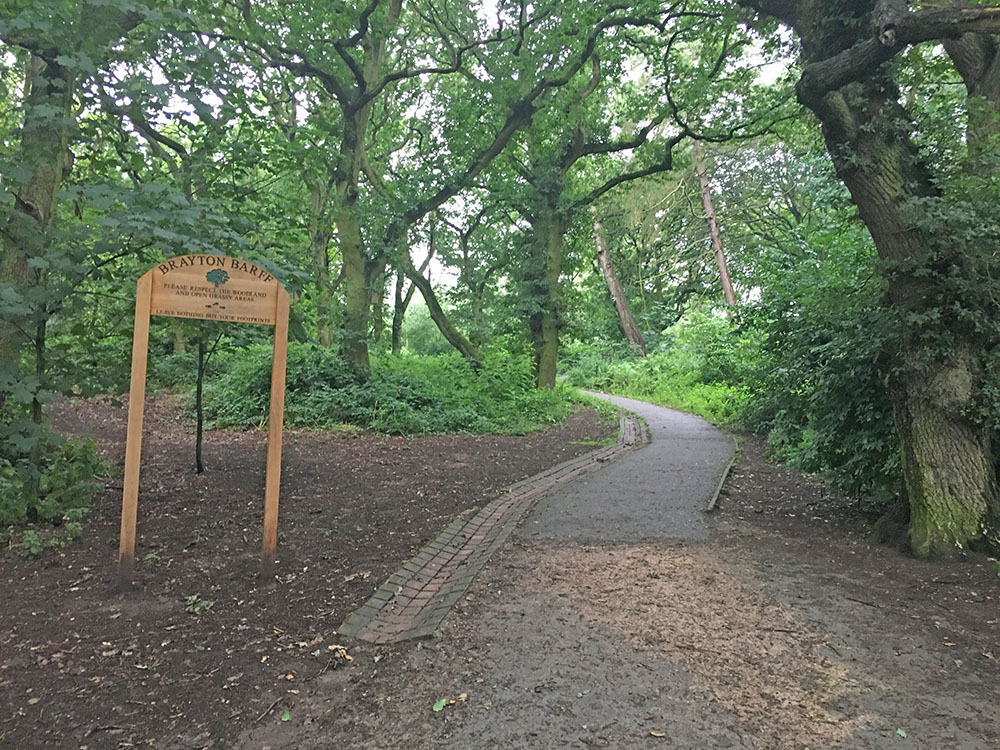
Today the site is primarily owned by Yorkshire Water with Selby District Council owning a small patch of the land adjacent to the A63 Selby bypass. A large underground reservoir occupies the centre of the site which delivers water to around 4.7 million customers throughout Yorkshire.
Within the Barff woodland over 40% of the trees are Sessile Oak which are generally found in semi natural woodlands in the north of the country. These trees are so called because its acorns are not held on stalks, like those of the English Oak (Pedunculate), but attached directly to the outer twigs. There are also several English Oak trees as well as some cross-hybrid oaks. These trees are known to support many species of flora and fauna, invertebrates, mosses, lichen and fungi.
During the Victorian times it is thought that the shipbuilders on the east coast would come over to the Barff for selected cuts of timber to build their sea going vessels.
The Barff also has a variety of other trees including Silver Birch, Beech, Sycamore, Holly, Rowan, Scots Pine, Alder, Hawthorne and European Larch. There are also several Yew, Willow, Hazel, Horse Chestnut and Wych Elm. As with similar woodlands there are a variety of bushes, including Honeysuckle, Elderberry, Gorse, Broom and Buddleia.
The history of Brayton Barff is quite vague, apparently during 1803 a beacon was lit on the Barff when the country was threatened with an invasion by Napoleon. In May 1935, to celebrate King George V's Silver Jubilee, a Bonfire was lit on the Barff as part of the celebrations.
Early issues of Ordnance Survey Maps dated 1903 clearly show a rifle range on the Barff, extending out to Mill Lane. During the 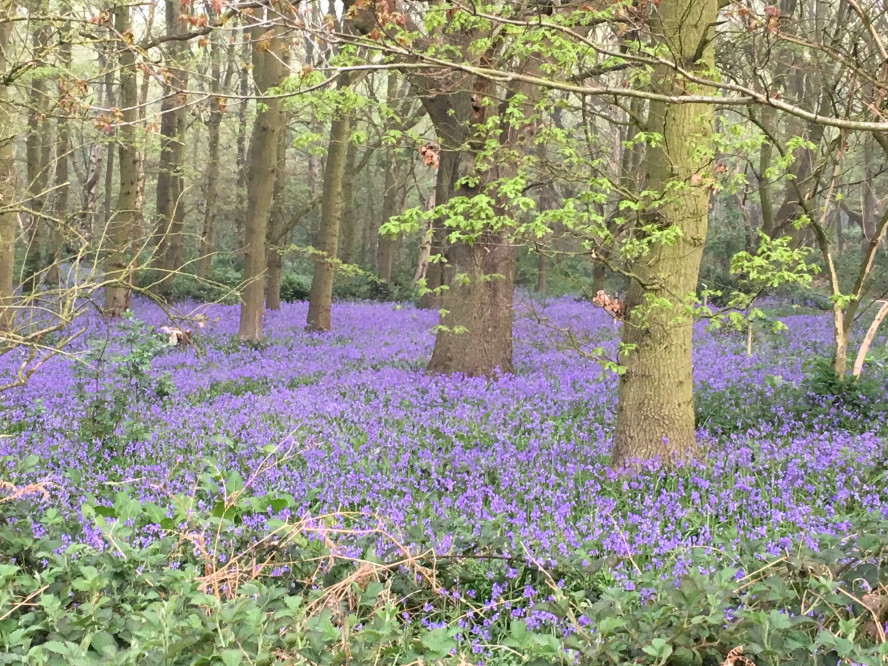
Between 2001 – 2004 the A63 Selby bypass, 10km twin lane single carriageway was constructed which severed the South West corner of the Barff, adjacent to Selby Golf Course and resulted in a slight redesign of several holes on the golf course. Wooden fencing was erected as a result of this new road running alongside of the Barff and a footbridge constructed over the ‘new road’ following the line of the Bridal way which extends from Mill Lane. Around 2005/2006 a definite 2metre wide limestone aggregate footpath was laid forming a circular path around the outer edges of the woodland. This footpath is approximately 1.2 miles in length and takes about 30 minutes to circumnavigate at a leisurely pace.
In 2012 the Barff was declared an Ancient Oak Woodland and as such throughout 2012 and 2013 significant work had been carried out by the relevant agencies to cut and remove large swathes of non-native trees, creating at that time huge scars on the landscape. Some three years later the planting of the native trees have become well established and are flourishing. Ongoing maintenance work on the footpath around the bottom of the Barff was completed during the Summer of 2016.
A second phase of woodland maintenance commenced during the Autumn of 2019 with the removal of many old and diseased trees and the cutting back of the Gorse and Broom bushes, especially adjacent to the ‘bypass trail’, this work continued through till March 2020 with re planting continuing into April 2020.
Brayton Barff is a popular site for walkers and bird watchers alike and a path circling the outer perimeter of the Barff makes a pleasant thirty minute walk, giving views looking over towards Selby and the village of Brayton as well as the power stations of Drax and Eggborough..jpg)
For the early risers it is a great place to see some stunning sunrises over the villages of Brayton looking towards Drax Power Station, the same with the Sunsets looking over towards Eggborough and Monk Fryston.
The Barff changes with the Seasons and every visit can reveal something new, the woodland is a haven for wildlife. Records show that since 1982 one hundred and twelve species of bird have been seen in the woodland and at least 40 of those have bred here, including Tawny Owl, Buzzard, Green Woodpecker, Spotted Flycatcher, Goldcrest and Nuthatch to name just a few. On average over 70 species of bird are recorded each year. Further details of the bird life on the Barff can be found on the Brayton Barff Group Facebook page, especially the posts from Derek Cooper. Today ‘The Friends of Brayton Barff group’ led by Derek and a small team of volunteers help keep and maintain the cleanliness of the site as well as recording the wildlife and bird sightings.
The Barff is also home to fifteen different species of mammals, including Muntjac Deer, Pipistrelle Bat, Fox, and Field Vole.
Over eighty species of plant and wildflowers have been recorded, included Bee Orchid, Northern Marsh Orchid, Wood Anemone, Marsh Ragwort, Bluebell, White Bluebell, Bittersweet and Purple and White Foxgloves. Over twenty species of Butterfly have been recorded, including Marbled White, Brown Angus, Speckled Wood, Comma and Brimstone.
During the Autumnal months fungi thrives in this woodland environment, species including Fly Agaric, Beefsteak Tree Fungi, Chicken of the Wood, Sulphur Tufts, Stinkhorn, Ink cap, Puffballs and Hoof Bracket are just some of the many varieties that can be found here.
Click on the galleries shown below to expand the albums.
April 2020
This month is usually all about Bluebells on the Barff and the arrival of our returning birds from Africa.
Unfortunately, the whole of the country is currently on a lockdown due to the Coronavirus pandemic that is widespread across the country. The UK government has closed all non-essential shops during the last week of March and further to that people were advised to stay at home, all the schools are closed less for pupils of key workers and people have been advised to use their car for essential travel only.
‘Yorkshire Water’ has closed off the car park to the Barff during the last week in March in line with the Governments guidelines, as have the National Trust and English Heritage there’s too, and all places of interest have been closed and people being advised to stay at home for the next three weeks, needless to say that due to the spread of the disease and loss of life, the lockdown has been extended further.
With all this going on alas I had other issues to worry about closer to home. Meg had picked up a bad stomach infection somehow, I took her to the vet on the Saturday morning and then again on the Monday, and to cut a long story short had to take her to the Veterinary hospital in Leeds late on Monday evening, where she stayed for the following week, undergoing a major operation and numerous tests and scans to ascertain the cause of her illness, if only dogs could talk. She was diagnosed with a gastric infection which later turned into an e coli infection. The staff at the hospital were amazing and after a significant course of antibiotics she return home the following week on Monday 6th April. In the meantime, I had been taking Gracie for some very pleasant long walks to and around the Barff. It is surprising how quiet the Barff has become since the car park has been closed, I remember it being like this some thirty years ago before all the housing developments were built.
One of the benefits of the lockdown has been the considerable lack of traffic on the roads, less noise pollution, and less visitors, meaning the wildlife can flourish without being disturbed. Tree planting has continued during the month.
Weather wise April started with some wet showers, although most of the rain occurred during the night time hours meaning I had some relatively dry dog walks first thing in the morning, in fact it turned out to be the sunniest April on record for the UK since records began in 1929.
With the lack of traffic noise from the adjoining Selby bypass the bird song and dawn chorus has become more noticeable, I have often heard the delicate sound of the Goldcrest something I don’t often hear due to other noise, Blackcap and Chiffchaff are regular early morning contributors with quite a repertoire, along with Nuthatch, Willow Warblers and Chiffchaff.
The Bluebells have been at their best this month, especially around the middle of the month, other wild flowers like Wood Anemone, Lesser Celandine and Wood Sorrell has been in full flower too, even the aromatic smell of Garlic mustard hovers in the early morning air.
Greater Spotted Woodpeckers have been busy drumming away in the hope of attracting a mate, I have watched a pair of Buzzards gliding on the thermals above the tree line throughout the month, though they are normally accompanied by a pair of Crows trying to harass them as much as possible. It was nice to hear the Willow Warbler return to the woodland early on in the month. I’ve spotted a Kestrel in amongst the trees on a couple of occasions during the middle of the month.
One of the other pleasant things about April is that several of the bushes and trees are coming into flower, including Cherry, Lilac, Apple and bushes such as Hawthorne and Broom too. The ferns are beginning to sprout from early April, and it is they that by the end of the month will overshadow the Bluebells. It is surprising how the colours on the Barff change, especially after a night of rain after a dry spell, it is as though the Barff comes alive with colour, all the greens look so much more vibrant.I managed a couple of quite early morning walks during April reaching the Barff for around 5.30am to see the sunrise, always quite a spectacle as it rises over the back of St Winifred’s church in Brayton.
Towards the end of the month I could make out the call of the Yellow Wagtail, Long Tailed Tits and Whitethroat (note that during the lockdown period I have been trying to listen to and recognise more bird songs!)
I am not certain as to how long the Coronavirus lockdown will continue for but as I write this note at the end of April 2020 some 26,700 people have lost their lives in the UK to the disease., lets hope that we are over the worse and the death toll starts to decline significantly during May.
|

